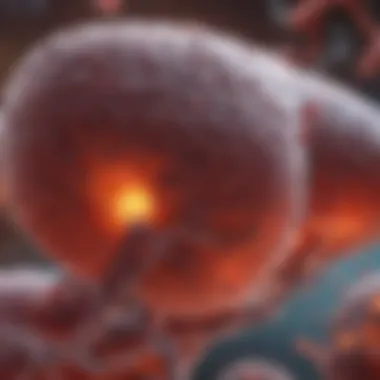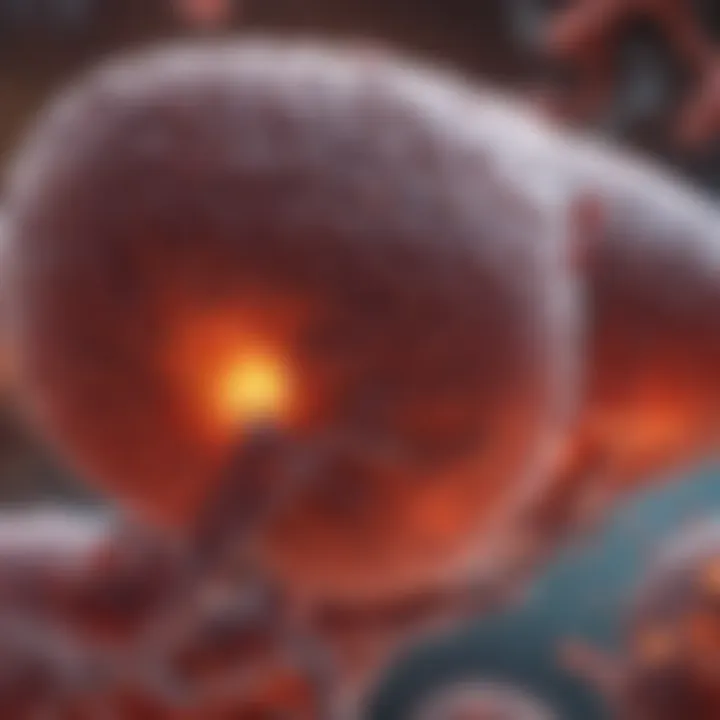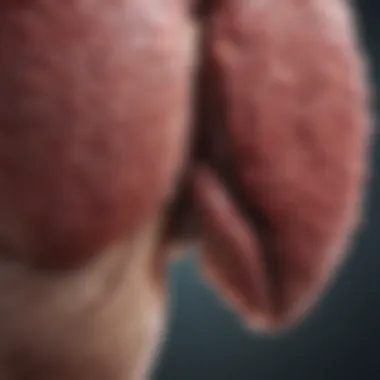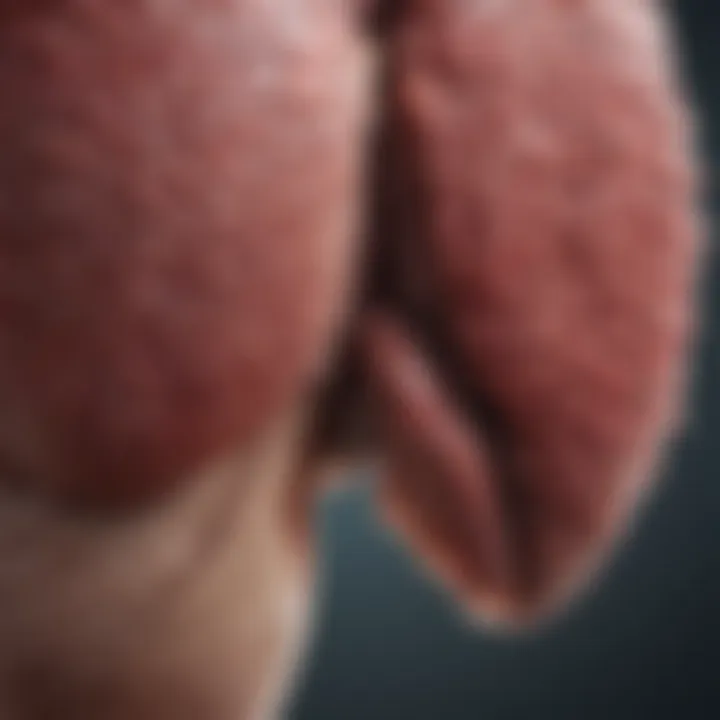Understanding Liver Clarity and Its Significance


Intro
The liver, often regarded as one of the hardest-working organs in the human body, plays a pivotal role in various biochemical processes. When it comes to health, a misconception looms large: that the liver operates smoothly, without any issues, simply because we don't feel any pain or discomfort. However, the condition known as liver clarity emerges as a crucial aspect warranting attention. This term refers to how well the liver functions in detoxifying, producing essential proteins, and maintaining overall bodily equilibrium.
Understanding liver clarity delves deep into both its functionality and the factors that contribute to its optimal performance. The implications of a clear liver stretch beyond the confines of hepatology, impacting everything from metabolic health to hormonal balance. In a world where lifestyle choices and environmental influences constantly challenge our health, examining how to sustain liver clarity is not just important, it's essential.
Foreword to Liver Clarity
Understanding liver clarity is akin to recognizing the importance of a smooth-running engine in a car. Just as a finely tuned engine translates to better performance and longevity, a clear and healthy liver plays a pivotal role in maintaining overall bodily health. This article will explore the multifaceted dimensions of liver clarity—what it is, how it functions, and why it matters.
A key element in this discussion is the liver’s central role in various biochemical processes. It handles the metabolism of nutrients, detoxifies harmful substances, and produces bile, which is essential for digestion. The concept of liver clarity involves not only the efficiency of these processes but also their impact on our physical and mental well-being. An impaired liver can throw a wrench in the whole system, affecting energy levels, digestion, and even mood.
To grasp liver clarity fully, one must delve into its definition and inhabiting historical context. Understanding both its physiological mechanics and historical perceptions underscores how humanity has viewed and managed liver health across different epochs. This knowledge forms the backbone of the subsequent sections, allowing readers to appreciate both the intricate workings of this organ and the relevance of its clarity to one’s health.
In essence, maintaining liver clarity is not just a matter of physical health. It weaves through the broader tapestry of lifestyle choices, dietary habits, and even historical views on health and wellness. Recognizing its importance enables proactive measures that can foster both preventive and restorative health strategies.
"A healthy liver is integral to a healthy life; it isn't just an organ but a cornerstone of our vitality."
Thus, through this exploration, one can hope to glean insight into the importance of nurturing liver health, which in turn resonates with achieving better overall wellness.
Anatomy and Physiology of the Liver
Understanding the anatomy and physiology of the liver is fundamental to grasping the significance of liver clarity. The liver, being one of the most vital organs in the human body, plays an array of roles that are indispensable for our health and well-being. By dissecting its intricate structure and the functionality within, we can appreciate how liver clarity directly influences our metabolism, detoxification, and overall organ health.
Liver Structure
The liver's structure is both robust and sophisticated, allowing it to fulfill its numerous functions efficiently. Composed of hepatocytes, which are the primary functional cells, the liver is divided into small units known as lobules. Each lobule is a hexagonal structure essential for organizing blood flow and processing metabolic products. Here are some key features:
- Portal Triads: Each lobule is bordered by portal triads that include a branch of the hepatic artery, the portal vein, and bile ducts. This configuration ensures a rich supply of blood and nutrients.
- Central Veins: At the core of each lobule is a central vein that collects processed blood, which eventually drains into the hepatic veins and then into the inferior vena cava.
- Sinusoids: These specialized capillaries, found between hepatocytes, are permeable enough to let nutrients and small proteins circulate freely, facilitating the crucial exchange needed for metabolism.
The liver can also regenerate, which is quite unique among organs. Even after surgical removal or injury, the liver can restore its size and function, which is a reflection of its resilience and adaptability.
Functional Zones
The liver is not a one-size-fits-all organ. Instead, it has distinct functional zones, each tailored for specific metabolic processes. Understanding these zones is critical for recognizing how liver clarity can be affected by different factors.
- Zone 1 (Periportal): Located near the portal triads, zone 1 is rich in oxygen and nutrients, making it ideal for functions like gluconeogenesis and amino acid metabolism.
- Zone 2 (Midzonal): This area serves as a bridge between the periportal and centrilobular zones, where various metabolic activities occur alongside detoxification processes.
- Zone 3 (Centrilobular): This zone is less oxygenated and plays a significant role in drug metabolism and detoxification of ammonia. However, because it is farthest from the source of blood supply, it is more susceptible to damage from toxins.
Understanding these functional zones can help clinicians identify where potential dysfunctions may arise, enhancing diagnostics and treatment of liver-related diseases.
Biochemical Functions of the Liver
The liver serves as a biological powerhouse, overseeing a myriad of biochemical functions essential for maintaining overall health. It acts as a central hub for metabolism, detoxification, and bile production, enabling the body to efficiently process nutrients, eliminate toxins, and support digestion. Understanding these processes not only sheds light on how liver clarity impacts well-being but also emphasizes the liver's critical role in homeostasis.
Metabolism
Metabolism is arguably one of the most critical functions of the liver. It encompasses a range of biochemical reactions that convert food into energy, synthesize vital substances, and regulate nutrient levels in the body. The liver plays a pivotal role in both catabolism, breaking down nutrients for energy, and anabolism, synthesizing essential biomolecules.
- Carbohydrate Metabolism: The liver helps to maintain blood sugar levels by converting excess glucose into glycogen for storage. When energy is needed, glycogen is re-converted into glucose and released into the bloodstream. This liver function is indispensable for maintaining energy levels, particularly in periods of fasting or strenuous activity.
- Protein Metabolism: The liver is a key player in protein synthesis, producing various proteins such as albumin, which helps regulate fluid balance, and clotting factors vital for blood coagulation. It also processes amino acids, transporting them to different body tissues for growth and repair.
- Fat Metabolism: The liver metabolizes fats by breaking them down into fatty acids and glycerol. It also plays a role in the synthesis of lipoproteins, which transport fats through the bloodstream. A malfunction in fat metabolism can lead to conditions like fatty liver disease, emphasizing the importance of liver clarity in metabolic health.
Detoxification Processes
The detoxification capabilities of the liver are what truly set it apart as an organ of immense importance. The liver filters blood coming from the digestive tract before it circulates to the rest of the body, allowing it to identify and neutralize harmful substances.
- Neutralization of Toxins: The liver receives toxins and other harmful chemicals, breaking them down into less harmful substances or preparing them for excretion. The cytochrome P450 enzyme system is instrumental in this process, converting fat-soluble toxins into water-soluble compounds that can be easily eliminated.
- Drug Metabolism: Many pharmaceuticals are processed by the liver, which can affect drug efficacy and duration of action. The liver modifies medications, facilitating their elimination while also active potentially toxic byproducts, which need to be cleared quickly.
- Hormonal Regulation: The liver also metabolizes hormones, ensuring that their levels in the bloodstream remain balanced. Disruptions in this balance can affect systems like metabolism, growth, and even mood.
"The liver is a master multitasker, juggling a plethora of biochemical responsibilities that keep the entire body in balance."
Bile Production
Bile, produced by the liver, is essential for digestion and absorption of dietary fats. This yellowish-green fluid contains bile salts, cholesterol, and bilirubin.
- Role of Bile Salts: Bile salts emulsify fats in food, breaking them down into smaller particles for easier absorption in the intestines. Without adequate bile production, the body struggles to digest fats, leading to nutritional deficiencies and gastrointestinal issues.
- Elimination of Bilirubin: Bile also carries bilirubin, a byproduct of red blood cell breakdown. The liver's ability to convert and excrete bilirubin is crucial; elevated bilirubin levels can lead to jaundice, a condition indicating liver dysfunction.
- Enterohepatic Circulation: Once secreted into the intestine, bile salts are partially reabsorbed and returned to the liver, creating a recycling system that ensures efficient digestion. This process exemplifies how liver clarity contributes to digestive health and nutrient utilization.
In summary, the biochemical functions of the liver encompass vital processes from metabolism to detoxification and bile production. Recognizing their significance not only underscores the liver's complexity but also emphasizes the importance of maintaining liver clarity for overall well-being.
Factors Affecting Liver Clarity
Understanding liver clarity isn’t a trivial endeavor. It holds importance throughout health discussions, shedding light on what we consume, how we live, and even our genetic make-up. In essence, the clarity of the liver is influenced by an intricate web of factors, which can either benefit or hinder this vital organ's functionality. With the liver acting as the body’s primary detoxifier, maintaining its clarity can lead to significant health benefits.


Dietary Influences
The foods we eat lay the groundwork for liver health. Each meal either nourishes or burdens this organ, making it crucial to understand how dietary elements play their part.
Nutritional Components
Taking a closer look at nutritional components, we see vitamins and minerals particularly stand out. For instance, B vitamins, or antioxidants like vitamin E, serve as powerhouse supporters of liver clarity. These components act as catalysts in various biochemical pathways that the liver governs, such as lipid metabolism.
You might say that they carry the torch for energy production, helping the liver efficiently convert food into energy while breaking down toxins. Interestingly, a diverse diet rich in whole foods—think leafy greens, nuts, and fatty fish—not only keeps the engine running but also fuels the liver’s ability to stay clear of impurities. Yet, it’s worth noting that some components, if taken in excess, could tilt the balance negatively.
- Key Characteristics: High nutrient density and antioxidant power make these foods imperative choices.
- Unique Features: Nutrient balance facilitates liver detoxification, potentially warding off diseases like fatty liver.
Toxins and Additives
On the flip side, we also need to face the reality of toxins and additives. These unwelcome guests appear in many processed foods and can slowly build up in the liver, creating a murky space instead of a clear one. Artificial preservatives, high fructose corn syrup, and food colorings can overwhelm the liver’s detox pathways. Their impact is quite concerning, as they often lead to long-term health implications.
Manufacturers might argue that these additives create appealing products, but the underlying cost to liver clarity cannot be disregarded. Some might even say they are ticking time bombs for eventual liver dysfunction.
- Key Characteristics: They can cause inflammation and oxidative stress, negatively impacting liver function.
- Unique Features: While they may enhance flavor and shelf-life, the risk of toxic buildup poses disadvantages worth heeding.
Lifestyle Choices
Lifestyle choices comprise another significant chapter in the liver clarity story. Our daily activities and habits have a considerable weight on how our liver functions.
Physical Activity
When it comes to physical activity, it’s like putting fuel into your liver’s engine. Exercise significantly enhances circulation and boosts metabolism, contributing to better liver health. Regular aerobic activities, such as running or cycling, not only burn calories but also promote blood flow to the liver, aiding in its cleansing processes.
Additionally, it has been demonstrated that individuals who maintain an active lifestyle tend to have lower levels of fatty liver—a common issue in sedentary populations. The unique aspect here lies in the correlation between movement and metabolic pathway efficiency; the more engaged we are physically, the less burdened our liver tends to be.
- Key Characteristics: Engaging in consistent physical activity directly influences liver function positively.
- Unique Features: Regular exercise can lower the risk of that stubborn fatty accumulation.
Substance Use
Turning to substance use, one can’t ignore the relationship between what we consume—alcohol, nicotine, and opioids—and liver clarity. Chronic use of these substances can lead to prolonged stress on the liver, ultimately causing significant damage.
Not to forget, moderation is key; the occasional drink might not spell disaster, but habitual overconsumption can lead to dire consequences. Alcohol, for instance, is metabolized primarily in the liver, and its excessive intake can lead to an inflammatory response, paved with long-term complications.
- Key Characteristics: Substance use vastly influences liver health; understanding this can lead to improved choices.
- Unique Features: While some substances may be socially acceptable, they carry potential risks that should not be overlooked.
Genetic Factors
At times, the influence of genetic factors cannot be taken lightly. Genetic predispositions may offer insights into how efficiently one’s liver detoxifies substances, underscoring the importance of personalized approaches to liver clarity.
Pathologies Linked to Liver Clarity
The health of the liver is far more than just a single organ's function—it ripples through the entire body. Condition of liver clarity matters greatly because it connects directly to various pathologies, many of which can lead to serious consequences if left unchecked. Understanding these pathologies is not only crucial for medical professionals but also for anyone who values their well-being. It brings into focus how liver clarity can influence overall health outcomes and highlights the important preventative measures we can take.
Fatty Liver Disease
Fatty liver disease encompasses a spectrum of conditions characterized by excessive fat accumulation in liver cells. This disease can be classified mainly into two types: alcoholic fatty liver disease (caused by heavy drinking) and non-alcoholic fatty liver disease (NAFLD), which is linked to obesity and metabolic issues. The latter has been gaining attention as rates of obesity soar globally.
When the liver becomes cluttered with fats, it can't perform its vital tasks effectively. This impaired function can escalate to inflammation, leading to non-alcoholic steatohepatitis (NASH), and can even evolve into cirrhosis over time.
Key indicators of fatty liver disease include:
- Elevated liver enzymes in blood tests
- Imaging studies showing fat in the liver
- Fatigue and discomfort in the upper right abdomen
Implementing lifestyle changes, such as a balanced diet and consistent exercise, is fundamental in reversing fatty liver disease and restoring liver clarity. The journey to recovery emphasizes the liver's resilience and the capacity for improvement through conscious choices.
Hepatitis
Hepatitis refers to an inflammation of the liver, often resulting from viral infections, but it can also arise from autoimmune diseases, excessive alcohol consumption, or drug use. There are several types of viral hepatitis, including hepatitis A, B, C, D, and E, each with different transmission methods and varying severities.
This condition can be clinically silent or remarkably aggressive. Chronic hepatitis, especially types B and C, poses significant threats to liver clarity, leading to long-term complications such as fibrosis or cirrhosis.
Recognizing hepatitis is paramount and often includes:
- Jaundice or yellowing of the skin and eyes
- Dark urine and clay-colored stools
- Abdominal pain, especially in the liver area
Preventative measures hinge on vaccinations, safe practices, and early detection, which can significantly improve patient outcomes and help maintain optimal liver function.


Cirrhosis
Cirrhosis represents the advanced stage of liver damage marked by scarring and loss of functionality. Various factors, including chronic hepatitis, heavy alcohol use, and non-alcoholic fatty liver disease, can foster its development. As the liver tissue degenerates, its ability to cleanse and detoxify deteriorates, cutting off essential liver clarity and leading to cascading health issues.
Symptoms often associated with cirrhosis include:
- Edema or swelling in the legs and abdomen
- Easy bruising and bleeding
- Confusion and mental health issues, commonly referred to as hepatic encephalopathy
Though cirrhosis carries a grim prognosis, early diagnosis and management strategies—including lifestyle modifications and medical interventions—can slow its progression and mitigate damage. Living with cirrhosis requires a vigilant approach to maintain what little liver clarity remains.
Ultimately, understanding these pathologies ensures that individuals can take informed steps toward safeguarding their liver health and, by extension, their overall well-being.
Diagnostic Approaches
Diagnosing liver clarity involves a series of methods that allow healthcare professionals to assess the functionality and overall health of the liver. Understanding these diagnostic approaches is crucial because a compromised liver often goes unnoticed until significant damage occurs. Timely diagnosis can lead to early intervention, which is vital for maintaining liver clarity and preventing more severe complications.
Blood Tests
Blood tests serve as a fundamental tool in assessing liver health. They provide valuable information regarding liver function and potential abnormalities. Common tests include liver enzyme tests, which measure levels of enzymes such as alanine aminotransferase (ALT) and aspartate aminotransferase (AST). Elevated levels of these enzymes can signal inflammation or damage within the liver.
Additionally, tests measuring bilirubin levels can illustrate how well the liver is processing waste. High levels of bilirubin can lead to jaundice, indicating liver dysfunction.
Some of the benefits of blood tests include:
- Non-invasive: These tests can be completed with a simple blood draw.
- Quick results: Often, results are available within a day or two, allowing for rapid assessment.
- Early detection: Anomalies in liver function can be identified earlier, which can be game-changing for treatment plans.
Imaging Techniques
Imaging techniques provide a visual representation of the liver, which is essential for diagnosing various conditions or assessing liver clarity. Among the most common methods are ultrasound, CT scans, and MRI.
- Ultrasound: This is usually the first imaging test conducted. It is safe, quick, and particularly useful for spotting fluid accumulation and other abnormalities within the liver.
- CT scans: These offer more detailed images and can help identify tumors, liver disease, or structural issues.
- MRI: This is less common but extremely useful in certain cases, especially when soft tissue contrast is needed.
Imaging is beneficial because:
- It provides a comprehensive view of liver anatomy and any pathological changes.
- Helps guide further assessment or management decisions.
- Non-invasive methods reduce the risk to the patient while delivering detailed insights.
Biopsy Procedures
In certain cases, a liver biopsy may be required to obtain a definitive diagnosis. This procedure involves taking a small sample of liver tissue. While it's typically considered a last resort due to its invasive nature, it can yield crucial information about the liver's condition. Biopsies are particularly effective in diagnosing liver diseases like hepatitis or fatty liver disease.
There are two primary types of biopsies:
- Percutaneous biopsy: Involves inserting a needle through the skin to collect tissue.
- Transjugular biopsy: Conducted via the jugular vein, this option is often selected for patients who cannot undergo percutaneous procedures due to clotting issues.
While biopsies do carry risks such as bleeding or infection, they have their advantages:
- They provide direct information regarding histological changes in liver tissue.
- They can identify the degree of liver damage or fibrosis, which is crucial for prognosis and treatment options.
In summary, the three diagnostic approaches—blood tests, imaging techniques, and biopsy procedures—offer a comprehensive strategy for evaluating liver clarity. Each method carries its own strengths and considerations but collectively enables a thorough understanding of liver health.
Maintaining Liver Clarity
Maintaining liver clarity is not just a health trend; it is a cornerstone for overall well-being. The liver, being one of the most vital organs in the body, acts as a filter for toxins and impurities, while ensuring essential biochemical processes are functioning smoothly. When the clarity of the liver is compromised due to poor diet, lack of exercise, or dehydration, it can lead to a cascade of health issues. Therefore, understanding how to maintain liver clarity is paramount for anyone looking to optimize their health.
Dietary Recommendations
Beneficial Foods
Beneficial foods play a significant role in sustaining liver health and clarity. Foods rich in antioxidants, vitamins, and minerals are particularly helpful. For instance, leafy greens such as kale and spinach can aid in detoxification processes due to their chlorophyll content, which absorbs toxins. Nuts, especially walnuts, are high in omega-3 fatty acids, contributing to improved liver function. A unique feature of these foods is their ability to enhance liver enzymes, promoting better detoxification. Health-conscious individuals often gravitate towards these foods because they provide a twofold advantage: boosting liver health while also fostering overall vitality.
- Key characteristics of beneficial foods:
- High in antioxidants
- Rich in essential fatty acids
- Promote detoxification
Conversely, while these foods may have clear advantages, a diet solely reliant on any single food type is not advisable. Variety in diet ensures that the liver gets a wide range of compounds necessary for optimal performance.
Avoiding Harmful Substances
Avoiding harmful substances is equally crucial in maintaining liver clarity. This encompasses steering clear of high-sugar snacks, excessive alcohol, and processed foods. The liver can only process a finite amount of toxins at a given time; overloading it can lead to fat buildup, a precursor to diseases like fatty liver disease.
A noteworthy aspect of avoiding these substances is not just about what is consumed but also rather what is excluded from the diet. For example, refined sugars can lead to raised blood sugar levels, prompting the liver to work harder to restore balance—a burden the liver did not sign up for.


- Key characteristics of avoiding harmful substances:
- Limits sugar spikes
- Reduces toxic load on the liver
- Enhances overall liver function
It’s important to note that completely eliminating certain foods can sometimes lead to feelings of deprivation, thus moderation is key. Finding a balance where harmful substances are minimized while including beneficial options can make the journey towards liver clarity both sustainable and attainable.
Regular Exercise Routines
Regular exercise routines contribute significantly to the functionality of the liver and its clarity. Physical activity increases blood circulation, enabling the liver to clear out toxins more efficiently. As simple as it sounds, integrating even moderate exercise—like walking or cycling—can have profound effects on liver health. Muscles utilize glucose more effectively during workouts, alleviating some of the strain from the liver.
Moreover, exercise helps to regulate body weight, which is vital since obesity is a well-known risk factor for liver conditions. Whether it's lifting weights, joining a local dance class, or playing recreational sports, the emphasis should be on consistency over intensity.
Hydration and its Importance
Hydration serves as a fundamental aspect often overlooked in liver maintenance. The liver requires ample amounts of water to effectively filter blood and transport nutrients. Dehydration forces the liver to function less optimally, as it becomes harder for it to process waste materials.
Experts suggest aiming for about eight glasses a day, adjusting based on individual needs and activity levels. Apart from just plain water, hydrating foods like cucumbers and watermelons can serve as excellent accompaniments. Maintaining proper hydration not only aids in liver clarity but also supports skin health and weight management, creating a holistic approach to well-being.
The Role of Medicinal Interventions
Medicinal interventions serve a crucial role in promoting liver clarity. The liver's ability to filter toxins and produce essential biochemicals makes it imperative to address any disruptions in its function. By utilizing a range of pharmaceuticals and dietary supplements, we can better manage liver health. This not only helps in restoring balance but also enhances overall wellness.
Pharmaceuticals and Supplements
When dealing with liver clarity, medications might come into play. These can range from prescription drugs aimed at specific liver diseases to over-the-counter supplements that claim to support detoxification. For instance, ursodeoxycholic acid is a medication often prescribed for conditions like cholestasis, helping to improve bile flow and alleviate symptoms associated with liver dysfunction.
Moreover, supplements such as milk thistle and N-acetylcysteine have been studied for their hepatoprotective properties. Milk thistle, specifically, is believed to help in regenerating liver tissue and reducing inflammation, while N-acetylcysteine is thought to replenish glutathione, a powerful antioxidant that plays a significant role in detoxifying the liver. However, it’s important to remember that not all supplements deliver on their promises.
"When it comes to liver health, knowledge is power. Understanding what goes into your body can greatly influence its performance."
A careful evaluation of the quality and source of these products is necessary, as not all dietary supplements are created equal. Regulatory oversight can be lax, and some products might even contain harmful additives that can do more harm than good. Consulting a healthcare provider before embarking on any medicinal regimen would be sage advice.
Prognosis and Management
When liver clarity is compromised, timely medicinal intervention can make the difference between minor adjustments and serious consequences. The prognosis for liver conditions often hinges on how early they are detected and treated. For instance, early management of fatty liver disease can sometimes enable a return to normal liver function, but neglecting it could lead to cirrhosis.
In a clinical context, a combination of treatment protocols—such as lifestyle modifications along with medications—improves the chances of a favorable outcome. Regular monitoring of liver function tests can help clinicians tailor treatment plans for individuals based on their specific health needs.
Long-term management often requires collaboration between the patient and healthcare providers. Educating patients about their conditions and empowering them to take an active role can facilitate better adherence to treatment. Lifestyle changes, such as dietary adjustments and increased physical activity, are critical aspects that complement medicinal interventions.
It's imperative that individuals are aware of their liver health status and understand the importance of proactive steps in their management plan. This holistic approach can lead to more effective and sustainable outcomes for liver clarity.
Future Directions in Liver Research
The ongoing exploration into the mechanisms underlying liver clarity is pivotal for advancing our understanding of hepatic health. Innovation in this field has far-reaching implications not just for treating liver disorders, but also enhancing overall bodily wellness. The future directions in liver research focus on several key components that will shape how we approach liver health moving forward.
Emerging Technologies
The rapid advancement of technology has opened numerous doors in the realm of hepatology. Here are some promising technologies that are influencing future liver research:
- Genomics: The application of genomic sequencing is offering unprecedented insights into how genes influence liver function and susceptibility to disease. By deciphering the genetic code, researchers can identify risk markers and create tailored prevention strategies for liver-related ailments.
- Bioinformatics: Leveraging bioinformatic tools allows researchers to analyze massive datasets gleaned from various studies. This analysis can lead to the identification of new biomarkers that signal liver health or degradation, ultimately aiding in earlier diagnosis and intervention.
- Wearable Devices: With the advent of smart technology, wearable devices may play a role in monitoring liver function in real time. These gadgets can track biometrics relevant to liver clarity, such as hydration levels and exercise, providing feedback for individuals and health professionals alike.
These technologies not only promise to enhance diagnostic precision but also encourage a more personalized approach to treatment, highlighting the unique biological makeup of each patient.
Innovative Treatment Options
Looking ahead, several innovative treatment options are on the horizon, grounded in research and technological advancement:
- Gene Therapy: The prospect of gene therapy presents a revolutionary path for treating liver diseases by correcting genetic defects at their source. This approach holds promise for conditions like Wilson’s disease or hereditary hemochromatosis, potentially eliminating the need for long-term medication.
- Stem Cell Therapy: Stem cell therapy is being investigated as a means to regenerate damaged liver tissue. By using stem cells, researchers aim to stimulate the liver's natural repair mechanisms, offering hope for individuals with chronic liver conditions.
- Nanomedicine: Utilizing nanoscale materials for drug delivery can enhance the bioavailability and efficacy of medications aimed at resolving liver issues. Techniques such as nanoparticle-based therapies can target specific liver cells, potentially reducing side effects and increasing treatment success.
"Emerging technologies and treatment innovations have the potential to radically transform how we approach liver health, making personalized medicine a reality."
As the field of liver research continues to evolve, it is essential to engage with these developments to improve outcomes for those suffering from liver-related health issues. Keeping abreast of these advancements will not only aid healthcare professionals but also empower patients in their pathways toward recovery.
Finale
The exploration of liver clarity and its mechanisms presents a vital topic that underscores the liver's multifaceted role in maintaining our health. Understanding liver clarity is not just an academic exercise; it is a gateway to appreciating how our daily choices—ranging from the food we consume to our lifestyle choices—impact this crucial organ and, by extension, our overall well-being.
Summary of Key Points
To distill the essence of this discussion, we can outline several key components that have emerged throughout the article:
- Definition of Liver Clarity: A clear understanding of what liver clarity entails helps in grasping its broader implications.
- Physiological Function: The liver performs essential biochemical processes such as detoxification and metabolism, which are intrinsic to maintaining clarity.
- Factors Influencing Clarity: Dietary habits, lifestyle choices, and genetic predispositions play significant roles in liver health.
- Impact of Pathologies: The article highlights diseases like fatty liver, hepatitis, and cirrhosis, illustrating how they affect liver function and clarity.
- Management Strategies: The importance of maintaining liver clarity through nutrition, exercise, and hydration offers practical takeaways for readers seeking to enhance their health.
Call for Continued Research
Engagement with interdisciplinary research, combining insights from fields such as biochemistry, nutrition, and genetics, is essential. Furthermore, educating the public about the significance of liver clarity and encouraging proactive health monitoring can build a foundation for better health outcomes.



